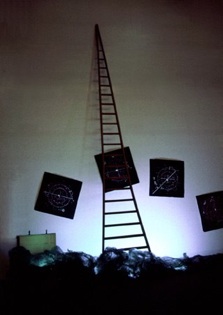Little Theatres of the Inanimate
Coming to grips with theatricality, a problematic throughout Wilson-Pajic’s career and an aspect of the installation that might be inherent. Deliberately dramatizing the presentation of a work in order to separate it from the rest of the world. Could be as simple as adding a light or as elaborate as making the entire exhibition space into a single dramatic presentation.
Dramatizing as a way of spotlighting an otherwise-ignored act, phenomena, object or person.
Keywords: art, avant-garde, contemporary art, performance art, performance, anti-performance, installation, sculpture, object, text, sound, video, sound installation, text installation, photography, photo-text, photogram, feminism, feminist art, theatre, film, still life Nancy Wilson Kitchel, recording, site-specific, environment, art context




















